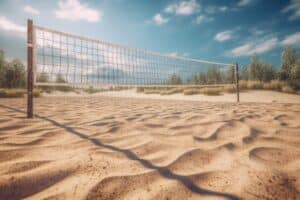How much sand do you need for a beach volleyball court?
Key Takeaways
- The standard measurements for a beach volleyball court sand area can vary, with dimensions ranging from 16 meters by 8 meters to 28 meters by 20 meters.
- The recommended depth of sand for a beach volleyball court is 12 to 24 inches (30 to 60 centimeters) deep.
- To calculate the amount of sand needed for a beach volleyball court, the formula is: (Length x Width x Depth in feet divided by 27) x 1.6.
Building a beach volleyball court requires careful planning and preparation. One important aspect to consider is the amount of sand needed for the court. The depth of the sand is crucial for player safety and optimal gameplay. In this article, we will explore the various factors to consider and provide an estimation of the amount of sand required for a beach volleyball court.
Factors to Consider
Before calculating the amount of sand needed, there are several factors to consider:
- Court Dimensions: The standard measurements for a beach volleyball court sand area can vary. According to USAVolleyball.org, the sand area should be 26 to 28 meters in length and 18 to 20 meters in width. However, other sources such as CourtsDimensions.com mention dimensions of 16 meters by 8 meters for doubles competition.
- Sand Depth: The depth of the sand is another important consideration. The recommended depth ranges from 12 to 24 inches (30 to 60 centimeters) deep. This depth provides a suitable playing surface and helps absorb shock during dives and falls.
Calculating the Amount of Sand
To calculate the amount of sand needed for a beach volleyball court, we can use the following formula:
(Length x Width x Depth in feet divided by 27) x 1.6
Using this formula, let’s assume we have a court with dimensions of 28 meters (92 feet) x 20 meters (66 feet) x 24 inches. First, we need to convert the dimensions to feet: 28 meters is approximately 92 feet and 20 meters is approximately 66 feet.
Next, we plug the values into the formula:
(92 ft x 66 ft x 2 ft) / 27 x 1.6 = 12,144 cubic feet
Therefore, the court would require approximately 12,144 cubic feet of sand. This is equivalent to approximately 200 to 600 tons of sand, depending on the density of the sand.
It’s important to note that the amount of sand required may vary based on the specific dimensions and regulations of the court in your location. It’s always recommended to research and follow the guidelines provided by official organizations such as USA Volleyball or the NCAA Beach Volleyball regulations.
Tips for Building a Beach Volleyball Court
Building a beach volleyball court involves more than just calculating the amount of sand. Here are some additional tips to help you properly prepare a beach volleyball court:
- Select the ideal location: Choose a flat and smooth area with enough space for the court. Consider factors such as proximity to facilities, tides, and erosion. (source: USAVolleyball.org)
- Gather necessary permits: Research and obtain the required permits and permissions for building a beach volleyball court in your area. (source: CourtsDimensions.com)
- Prepare the ground: Clear the area of any debris, plants, and ensure proper drainage to avoid waterlogging. Create a level surface for the court. (source: USAVolleyball.org)
- Choose the right equipment and materials: Invest in quality nets, sturdy poles, and durable boundary lines and markers. (source: CourtsDimensions.com)
- Set up the net and poles: Measure and position the net and poles correctly, ensuring they are secure and the net is at the right height according to the regulations. (source: USAVolleyball.org)
- Install the boundary lines and markers: Measure and mark the court accurately using durable materials that can withstand the beach environment. (source: USAVolleyball.org)
- Spread and compact the sand: Aim for a depth of 30 centimeters (12 inches) of sand, spread it evenly across the court, and use a compactor to firm it up. (source: USAVolleyball.org)
- Water and settle the sand: Sprinkle water on the sand to help with compaction and let it settle before using the court. (source: USAVolleyball.org)
- Test the court: Inspect the playing surface for any bumps or uneven spots, check the net height and boundary lines, and ensure compliance with regulations. (source: USAVolleyball.org)
- Landscaping and aesthetics: Consider adding native beach vegetation and decorative elements to enhance the court’s ambiance. Provide seating areas and shade for comfort. (source: USAVolleyball.org)
- Safety measures: Add padding to poles, eliminate potential hazards, keep a stocked first aid kit nearby, and have an emergency plan in place. (source: USAVolleyball.org)
- Court maintenance and cleaning: Regularly clean the court surface, remove debris and excess sand, and use gentle cleaning techniques to maintain its condition. (source: USAVolleyball.org)
Conclusion
Building a beach volleyball court requires careful planning, attention to detail, and adherence to regulations. The amount of sand needed for a beach volleyball court can vary based on the court dimensions and sand depth. By following the proper guidelines and using the provided formula, an estimation can be made to determine the required amount of sand.
Remember to consider the specific measurements and regulations for your location, as they may differ from standard guidelines. Additionally, ensure that you follow all necessary steps for preparing the ground, setting up equipment, and maintaining the court to create a safe and enjoyable playing environment.
Related Websites:
- USA Volleyball – How to Build a Beach Court
- HomeCourt – How to Build a Beach Volley Court
- CourtsDimensions.com – Beach Volleyball Court Dimensions
- Sports Imports – Beach Volleyball Court Dimensions
- CourtsDimensions.com – How to Build a Sand Volleyball Court
- Hobbitish – How to Build a Sand Volleyball Court
FAQs:
Q: Why is knowing the dimensions of a beach volleyball court important?
Knowing the dimensions of a beach volleyball court is important to ensure a proper playing surface. Accurate measurements are necessary for players to have enough space to move around and for the court to meet the standard requirements.
Q: What is the recommended depth of sand for a beach volleyball court?
The recommended depth of sand for a beach volleyball court is typically around 12 inches. This specific depth is important for player safety, optimal ball bounce, and to provide a suitable playing surface.
Q: How do I calculate the amount of sand needed for a beach volleyball court?
To calculate the amount of sand needed for a beach volleyball court, follow these steps:
1. Multiply the length by the width by the desired depth of sand.
2. Convert the result to cubic feet or cubic meters.
3. Adjust the quantity based on any influencing factors, such as soil conditions or erosion.
Q: Why is quality sand important for a beach volleyball court?
Using quality sand for the foundation of a beach volleyball court is crucial for optimal gameplay. Quality sand ensures proper drainage, reduces the risk of injuries, and improves overall performance.
Q: How can I maintain the levelness and cleanliness of the sand on a beach volleyball court?
To maintain the levelness and cleanliness of the sand on a beach volleyball court, you can:
1. Regularly rake the sand to redistribute and level it.
2. Remove any debris or foreign objects from the court.
3. Install sand retaining borders or barriers to prevent erosion.
4. Consider adding sand additives or conditioners to improve stability and prevent compaction.






